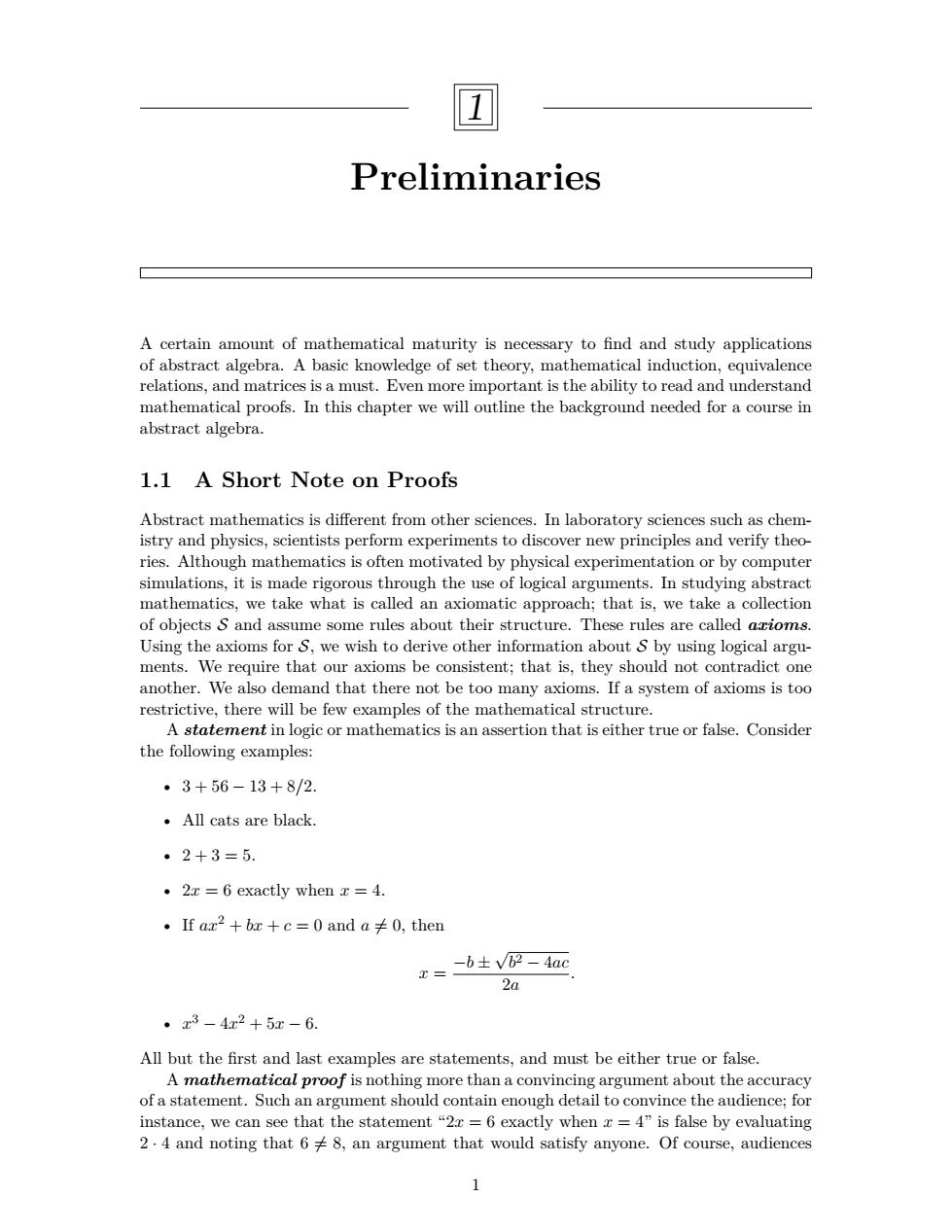正在加载图片...

Preliminaries A certain amount of mathematical maturity is necessary to find and study applications of abstract algebra.A basic knowledge of set theory,mathematical induction,equivalence relations,and matrices is a must.Even more important is the ability to read and understand mathematical proofs.In this chapter we will outline the background needed for a course in abstract algebra. 1.1 A Short Note on Proofs Abstract mathematics is different from other sciences.In laboratory sciences such as chem- istry and physics,scientists perform experiments to discover new principles and verify theo- ries.Although mathematics is often motivated by physical experimentation or by computer simulations,it is made rigorous through the use of logical arguments.In studying abstract mathematics,we take what is called an axiomatic approach;that is,we take a collection of objects S and assume some rules about their structure.These rules are called axioms. Using the axioms for S,we wish to derive other information about S by using logical argu- ments.We require that our axioms be consistent;that is,they should not contradict one another.We also demand that there not be too many axioms.If a system of axioms is too restrictive,there will be few examples of the mathematical structure. A statement in logic or mathematics is an assertion that is either true or false.Consider the following examples: 。3+56-13+8/2 All cats are black. ·2+3=5. 2x =6 exactly when =4. ·Ifax2+br+c=0anda≠0,then x=-b±VP-4ac 2a ·x3-4x2+5x-6. All but the first and last examples are statements,and must be either true or false. A mathematical proof is nothing more than a convincing argument about the accuracy of a statement.Such an argument should contain enough detail to convince the audience;for instance,we can see that the statement "2x =6 exactly when x=4"is false by evaluating 2.4 and noting that 68,an argument that would satisfy anyone.Of course,audiences 11 Preliminaries A certain amount of mathematical maturity is necessary to find and study applications of abstract algebra. A basic knowledge of set theory, mathematical induction, equivalence relations, and matrices is a must. Even more important is the ability to read and understand mathematical proofs. In this chapter we will outline the background needed for a course in abstract algebra. 1.1 A Short Note on Proofs Abstract mathematics is different from other sciences. In laboratory sciences such as chemistry and physics, scientists perform experiments to discover new principles and verify theories. Although mathematics is often motivated by physical experimentation or by computer simulations, it is made rigorous through the use of logical arguments. In studying abstract mathematics, we take what is called an axiomatic approach; that is, we take a collection of objects S and assume some rules about their structure. These rules are called axioms. Using the axioms for S, we wish to derive other information about S by using logical arguments. We require that our axioms be consistent; that is, they should not contradict one another. We also demand that there not be too many axioms. If a system of axioms is too restrictive, there will be few examples of the mathematical structure. A statement in logic or mathematics is an assertion that is either true or false. Consider the following examples: • 3 + 56 − 13 + 8/2. • All cats are black. • 2 + 3 = 5. • 2x = 6 exactly when x = 4. • If ax2 + bx + c = 0 and a ̸= 0, then x = −b ± √ b 2 − 4ac 2a . • x 3 − 4x 2 + 5x − 6. All but the first and last examples are statements, and must be either true or false. A mathematical proof is nothing more than a convincing argument about the accuracy of a statement. Such an argument should contain enough detail to convince the audience; for instance, we can see that the statement “2x = 6 exactly when x = 4” is false by evaluating 2 · 4 and noting that 6 ̸= 8, an argument that would satisfy anyone. Of course, audiences 1